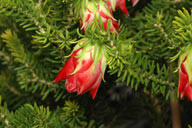In Flower This Week
A news sheet prepared by a Gardens' volunteer.
Numbers before each plant refer to temporary IFTW labels in the gardens.
Numbers in square brackets [ ] refer to garden bed Sections. Plants in flower are in bold type.
View past issues of 'In Flower This Week'.
11 November 2015
Darwinia oxylepis click for larger image |
Today we will visit the Rock Garden.
- As you stand in front of the waterfall at the entrance to the Rock Garden you will see Eremophila christopheri [Section 15v], an open bush with green foliage and mauve tubular flowers. It is native to central Australia. This plant was named after the explorer Christopher Giles, who first collected the species.
- Also in front of the waterfall is Dampiera lanceolata [Section 15v], or Grooved Dampiera, with sticky green foliage and deep purple flowers on a small bush. This plant is native to southeastern Australia.
- As you start up the steps on your right is Hibbertia pedunculata [Section 15d], a groundcover with close green foliage and bright yellow flowers. It is found in the wild in southeastern Australia.
- On your right is Lomatia tinctoria [Section 15d], a large bush with divided green foliage and sprays of cream flowers. Commonly known as Guitar Plant, this is one of the three species of Lomatia endemic to Tasmania.
- On your left is Leptospermum variabile [Section 15d], a small tree with many graceful branches, green foliage and white “tea-tree” flowers. It is native to the coastal areas of northern New South Wales and southern Queensland.
- Also on your left is Eremaea pauciflora var. pauciflora [Section 15b], a small sprawling shrub with bright orange flowers and yellow stamens. It grows naturally in southwest Western Australia.
- On your right is Hibbertia serpyllifolia [Section 15f], or Hairy Guinea Flower, showing very fine light green foliage with 5-petalled lemon flowers in profusion. It grows naturally in southeastern Australia.
- Again on your right Hibbertia fasciculata [Section 15f] is a small dense bush with yellow-green foliage and small yellow flowers. It is endemic to southeastern Australia.
- On your left is Homoranthus bornhardtiensis [Section 15a], with arching stems of close grey-green foliage and acid yellow flowers. This plant grows only in a small area east of Barraba, New South Wales, and is listed as endangered.
- Low on your right is Verticordia galeata [Section 15f], with small, bright yellow honey-scented flowers in profusion. It is found naturally near Geraldton, Western Australia.
- Cross the plank bridge to your left to see in a pot on your left Olearia megalophylla [Section 15m], with strongly scented heads of white daisy flowers with yellow centres. The large leaves are dark green above and woolly underneath. This plant is native to southern New South Wales and Victoria.
- Darwinia oxylepis [Section 15r], in a pot on your left, is a small bush with bright green foliage and pink bell flowers with paler pink inside. It is found in the Stirling Ranges of Western Australia.
- Look to your left to see Labichea lanceolata subsp. lanceolata [Section 15r], a large bush with bright green foliage and yellow flowers with a red throat. This plant is found naturally in southwest Western Australia, and is named after Jean Jacques Labiche (1748–1819), a second lieutenant on Freycinet's voyage round the world in 1817–20.
- Also on your left is Alyogyne huegelii ‘West Coast Gem’ [Section 15r], with clear purple “hibiscus”-like flowers that open for a short period only, but are prolific. The bush is medium-sized with coarse foliage
- Further on your left is Eremophila bignoniiflora x polyclada with large white bell flowers with purple spots on an open shrub with shiny linear leaves.
Rosalind Walcott
![Director of National Parks [logo]](../../../../images/dnp_90px.gif)







